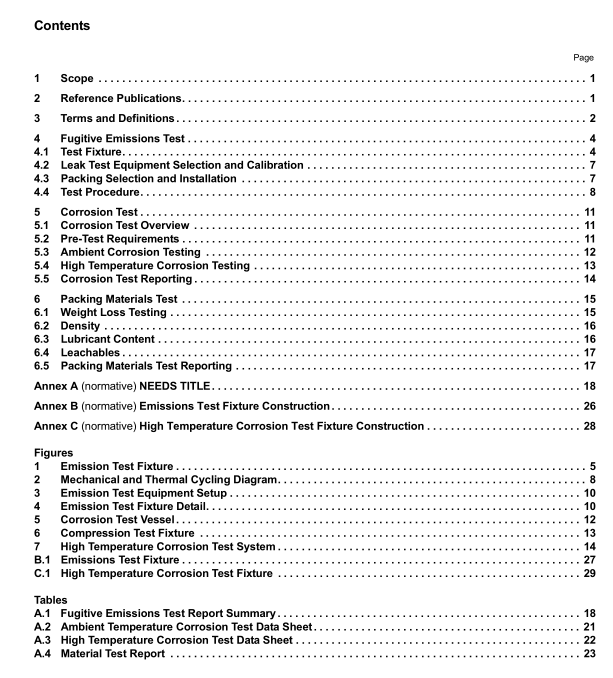API STD 622 pdf download

API STD 622 pdf download Type Testing of Process Valve Packing for Fugitive Emissions
4.1.8 The fixture shall be heated using an external heat source, blanket, heating coils or other suitable equipment.NOTE Refer to ASME Section vll Division 2, Section 5.5, for information on fatigue analysis methodology.
4.2Leak Test Equipment Selection and Calibration
4.2.1 Monitoring equipment shall be a flame ionization organic vapor analyzer capable of providing on-board datalogging with digital readout. The equipment shall be certified as intrinsically safe for use with the test fluid.
4.2.2 The equipment shall meet the following performance requirements in the flame ionization mode usingmethane as the test fluid.
a) Variation: less than ± 2 % at 100 ppm.b) Dynamic range: 1.0 ppm to 50,000 ppm.c) Linear range: 1.0 ppm to 10,000 ppm.
d) Minimum detectable level (defined as 2 times the peak noise): 300 ppb hexane.e) Maximum response time to reach final value: 3 seconds.
f) Maximum recovery time to return to 10 % of initial value: 5 seconds.
g) Sample flow rate at probe inlet: 1.14 V/min to 1.51 !/min (0.30 gal/min to 0.40 gal/min).
4.2.3 The testing equipment shall be calibrated according to the manufacturer’s directions. A current record of testequipment calibration shall be maintained by the test facility.
4.2.4The test equipment shall be inspected prior to each use to insure against fouling of the detector probe. Thisshall be done to EPA Method 21, using an external calibration gas with a known methane concentration.
4.3Packing Selection and lnstallation
4.3.1 Pre-qualification
Packing submitted for type testing shall be certified by the packing manufacturer to be suitable for the conditionsindicated in Section 1 of this standard.
4.3.2 Packing Selection
4.3.2.1 Test packing shall be selected at random from either:
a) a standard production lot as supplied by the manufacturer, orb) a distributor stock.
4.3.2.2 Test packing shall be 6.3 mm (1/4 in.) cross-section for the test fixture. Validation of a random selectionprocess shall be provided to the testing facility. Packing in production shall be pulled from standard production line.Random selection is not applicable for prototype material.
4.3.3 Packing lnstallation
A qualified laboratory representative or technician shall install the packing according to the manufacturer’s standardinstallation instructions except that the maximum packing bolt stress shall not exceed 172,369 kPa (25,000 psi).However,the packing stress (load) during the testing shall not exceed the packing manufacturer’s recommendedmaximum value.
4.3.3.1Instructions for all packing installations:
a) all test fixture components shall be thoroughly cleaned with acetone or equivalent solvent prior to testing;b) any reconditioned parts shall be inspected and shall comply with the requirements of 4.1.2;
c) components shall be inspected for damage prior to assembly;
d) caution shall be taken to avoid contact between the stem and gland;e) fasteners shall be lubricated;
f)gland(flange) height measured from a specific datum shall be recorded;g) special preparation of the packing or assembly components is prohibited.4.4Test Procedure
4.4.1Test Fluid
The test fluid used shall be dry methane gas, 97 % minimum purity, subjected to a temperature range from ambient to260 °C(500 °F) and pressures from o kPag to 4,137 kPag (0 psig to 600 psig) (see Figure 2).
4.4.2Mechanical and Thermal Cycling
4.4.2.1 Packing in test rigs shall be subject to a total of 1510 mechanical cycles and 5 themal cycles per Figure 2.Mechanical and thermal cycling shall begin with the test fixture at ambient temperature.
4.4.2.2 Test Profile
The following are recommendations for accomplishing the testing cycles in Figure 2.
a) Test duration of five, 8 hour maximum days, and one, 2 hour maximum mechanical cycling day.
b) Mechanical cycles per day are 300.
c) Temperature cycle per day is 1.
— Pressure stays at 4,137 kPag ± 34 kPa (600 psig ± 5 psig).
— Cycles at ambient are 150.
— Cycles at 260 °C ± 3 °C (500 °F ± 5 °F) are 150.
d) Reduce the pressure to zero at the end of each day (thermal cycle).
e) Minimum daily cycling is to be divided up as follows:
— Ambient cycling at pressure is 3 hours.
— Max. 2 hours to bring up to temperature (no cycling during this time).
— Elevated temperature cycling is 3 hours.
— Daytime or Overnight cool down with no cycling during this period.
4.4.3 Leak Measurement









